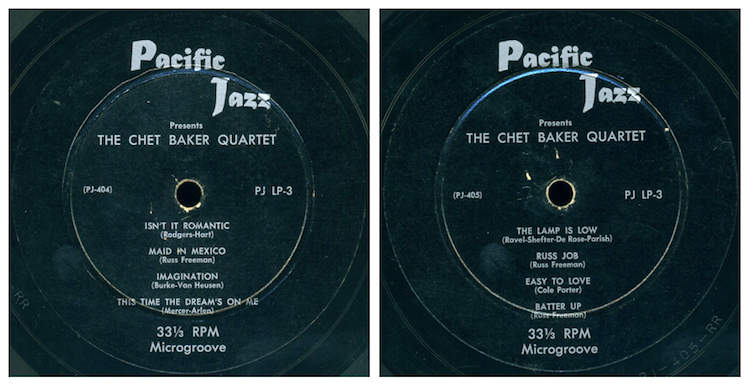THE CHET BAKER QUARTET: FIRST RECORDINGS
PART THREE
© James A. Harrod, Copyright Protected, All Rights Reserved
The European release of Chet Baker’s first 10” LP, Pacific Jazz PJLP-3, on UK Vogue (L.D.E. 045), French Swing (M. 33.308) and Swedish Karusell (KLP - 1) replaced THE LAMP IS LOW with WINTER WONDERLAND. The Swing LP label did not register the change and listed THE LAMP IS LOW in error. The UK LP listed the title correctly and credited the personnel as Chet Baker (tp), Russ Freeman (p), Bob Whitlock (b) and Bobby White (dm). The Karusell LP and EP releases did not register the change and listed THE LAMP IS LOW in error. The Vogue and Swing LPs were available for sale in Europe in September and October of 1953.
I am in the process of moving my work on this platform to a new home that unites all of my jazz research under one roof. Thank you for looking at my work here at google blogger. I think you will find the new home more user friendly with links and tags to all of my research. This link will take you to this research at the new site.
The European release of Chet Baker’s first 10” LP, Pacific Jazz PJLP-3, on UK Vogue (L.D.E. 045), French Swing (M. 33.308) and Swedish Karusell (KLP - 1) replaced THE LAMP IS LOW with WINTER WONDERLAND. The Swing LP label did not register the change and listed THE LAMP IS LOW in error. The UK LP listed the title correctly and credited the personnel as Chet Baker (tp), Russ Freeman (p), Bob Whitlock (b) and Bobby White (dm). The Karusell LP and EP releases did not register the change and listed THE LAMP IS LOW in error. The Vogue and Swing LPs were available for sale in Europe in September and October of 1953.
Jepsen’s JAZZ RECORDS, page 178, credited an October 27, 1953 recording session as the source of WINTER WONDERLAND with Chet Baker (tp), Russ Freeman (p), Joe Mondragon (b) and Shelly Manne (dm).
Lerfeldt and Sjøgren supply essentially the same information in their CHET - The Discography of Chesney Henry Baker from 1985 adding an alternate take of The Thrill Is Gone with modifications regarding where it was released.
Thorbjørn Sjøgren revised the discography that he and Hans Henrik Lerfeldt had compiled in 1985. The new edition was published in 1993.
The entry for the October 27, 1953 session listed an alternate take for WINTER WONDERLAND and questioned which version appeared on some European releases. Sjøgren corrected the previous listings in Jepsen and his joint effort with Lerfeldt that included WINTER WONDERLAND on PJLP-3.
The availability of the UK Vogue and French Swing LPs with WINTER WONDERLAND in the fall of 1953 casts some doubt regarding the date listed in the Jepsen, Lerfeldt/Sjøgren and Sjøgren discographies. It would seem that the albums with WINTER WONDERLAND were available the same month it was recorded if not before?
Carson Smith and Larry Bunker had replaced Bob Whitlock and Bobby White as regular members of Chet’s quartet in April of 1953 when the balance of PJLP-3 was recorded. Smith and Bunker would accompany Chet and Russ at their first live concert appearance at the Carlton Theater in August of 1953 and would be in the recording studio again on October 3, 1953 to record tunes for their second LP for Pacific Jazz.
The October 27, 1953 date with Mondragon and Manne replacing Smith and Bunker is supported by the information that Dick Bock listed on the 78 single release with two numbers from that session.
Dick Bock did not list all of the personnel on I Fall In Love Too Easily on PJ-614 and The Thrill Is Gone on PJ-615, both purportedly from the same October 27, 1953 recording session. Instead, the labels credit only Chet Baker, Vocal and Trumpet. The matrix numbers do not provide any clues regarding the dating of the recording session as Bock was assigning numbers in chronological order as records were prepared for release, and had ceased to assign numbers to tunes as they were taped in a recording session. The matrix numbers for the 78 single release, PJ-614, were PJ 306 and PJ 307. The same tunes on the 45 single, 45-614, were assigned matrix numbers PJ-308 and PJ-309.
Pacific Jazz licensed WINTER WONDERLAND and THIS TIME THE DREAM’S ON ME to UK Vogue where they were released as a 78 single, V2232. The labels credited the original members of the Chet Baker Quartet; Chet Baker (tp), Bob Whitlock (b), Russ Freeman (p) and Bobby White (dm). UK release date unknown.
UK Vogue included WINTER WONDERLAND along with two other tunes credited to the original Chet Baker Quartet with Bob Whitlock and Bobby White on EPV 1007, an extended play release. The fourth tune, IMAGINATION, was from the April 1953 session with Carson Smith and Larry Bunker. Date of release in the UK unknown.
French Vogue issued WINTER WONDERLAND coupled with three other Chet Baker Quartet selections on EPL 7039. The personnel credit on the back liner of the jacket listed Mondragon and Manne on WINTER WONDERLAND but mixed up the bass credits where Bob Whitlock should have been credited on MAID IN MEXICO and Carson Smith credited on IMAGINATION.
We are thus presented with conflicting information regarding the members of the Chet Baker Quartet recording of WINTER WONDERLAND. Initial releases on UK Vogue placed this session with Bob Whitlock and Bobby White in the first recording session for Chet’s original quartet in December of 1952. The appearance on UK Vogue and French Swing 10” LPs in September/October of 1953 would indicate that a recording date of October 27, 1953 was impossible.
A future presentation exploring the formation of the Chet Baker Quartet in the fall of 1952 will present some theories regarding this quandary, stay tuned!






.png)








.png)





















